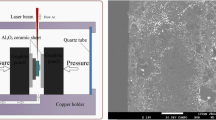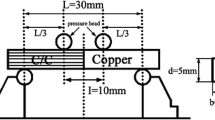Abstract
Carbon fiber reinforced SiC (Cf/SiC) ceramic matrix composites (CMC), which exhibit excellent properties at high temperatures, have been considered as a desirable high-temperature structural material in aeronautical turbines and advanced rocket propulsion thrust chambers. In many applications, the joining of Cf/SiC to itself or to metals is necessary to fabricate complex structural components and the joints must retain their properties at high temperatures. In the present paper, six AuNi(Cu)-Cr brazing fillers were designed for joining of Cf/SiC composite. The filler alloys were fabricated into foils with a thickness of 0.1 mm by a rapidly solidifying technique. The alloys’ wettability on the Cf/SiC composite was studied with the sessile drop method. The result showed that the wettability of AuNi(Cu)-Cr brazing alloys was improved with the increase of the Cr content. The microstructures of the Cf/SiC joints were examined with SEM, EDS and EPMA. It was found that element Cr participated in the interfacial reactions, and a thin Cr3C2 reaction layer was formed between the composite and the brazing fillers. The element Ni significantly diffused into the Cf/SiC matrix and reacted with SiC, and then Ni2Si compound was formed. The Cf/SiC joints brazed with Au-Ni20-Cr10 (wt, %) and Au70-Ni10-Cu10-Cr10 (wt, %) exhibit average three-point bend strengths of 154.5 and 171.6 MPa at room temperature, respectively. However, there is a remarkable difference for the two kinds of joints in bend strength at 600 °C, that is, the former is 75.2 MPa while the later decreased to 28.6 MPa. Element Cu in AuNi-Cr system alloys can increase room temperature strength of Cf/SiC joints, but it is harmful to the strength at elevated temperature. When the test temperature reached 700 °C, the bend strength of the two kinds of joints was further decreased to 17.7 and 9.8 MPa, respectively.









Similar content being viewed by others
References
Naslain R (2004) Design, preparation and properties of non-oxide CMCs for application in engines and nuclear reactors: an overview. Compos Sci Technol 64(2):155–170
Sommers A, Wang Q, Han X, T’Joen C, Parkd Y, Jacobi A (2010) Ceramics and ceramic matrix composites for heat exchangers in advanced thermal systems: a review. Appl Therm Eng 30:1277–1291
Feng J, Zhang C, Feng J, Jiang Y, Zhao N (2011) Carbon aerogel composites prepared by ambient drying and using oxidized polyacrylonitrile fibers as reinforcements. ACS Appl Mater Interfaces 3:4796–4803
Ge ML, Tian CY, Sun JG (2003) Application of C/C and C/SiC based composites for foreign liquid propellant rocket engines. Missiles Space Veh 4:22–26 (in Chinese)
Singh M, Asthana R (2007) Brazing of advanced ceramic composites: issues and challenges. Ceram Trans 198:9–14
Locatelli MR, Tomsia AP, Nakashima K, Dalgleish BJ, Glaser AM (1995) New strategies for joining ceramics for high-temperature applications. Key Eng Mater 111–112:157–190
Xiong J, Li J, Zhang F, Huang W (2006) Joining of 3D C/SiC composites to niobium alloy. Scr Mater 55(2):151–154
Chen B, Xiong HP, Cheng YY, Mao W, Ye L, Li XH (2010) Microstructure and strength of Cf/SiC joints with Ag-Cu-Ti brazing fillers. J Mater Eng 10:27–31 (in Chinese)
Jimenez C, Mergia K, Moutis NV, Azpiroz XA, Wilhelmi C, Speliotis T, Messoloras S (2012) Joining of Cf/SiC ceramics to nimonic alloys. J Mater Eng Perform 21:683–689
Tong Q, Cheng L (2006) Liquid infiltration joining of 2D C/SiC composite. Sci Eng Compos Mater 13:31–36
Xiong HP, Chen B, Mao W, Li XH (2012) Joining of Cf/SiC composite with Pd-Co-V brazing filler. Weld World 56(01–02):76–80
Chen B, Xiong HP, Mao W, Cheng YY, Ye L, Wu X, Li XH (2006) Wettability of Pd-Ni based brazing fillers on Si3N4 ceramic and interfacial bonding. J Aeronaut Mater 26(5):41–45 (in Chinese)
Xiong HP, Chen B, Mao W, Ye L, Li XH (2015) Wettability of PdNi(Co)-Cr alloys on Si3N4 ceramic and joining of Si3N4 to Si3N4. Weld World 59:33–44
Chen B, Xiong HP, Mao W, Li XH (2008) Wettability of several high-temperature brazing fillers on C/C composites. J Mater Eng 1:25–29 (in Chinese)
Baker H (1992) Binary phase diagrams, ASM Hand book, Alloy Phase Diagrams, ASM International, Materials Park, Ohio, Section 2, 3
Xiong HP, Chen B, Pan Y, Zhao HS, Ye L (2014) Joining of Cf/SiC composite with a Cu-Au-Pd-V brazing filler and interfacial reactions. J Eur Ceram Soc 34(6):1481–1486
Xiong HP, Chen B, Pan Y, Mao W, Cheng YY (2014) Interfacial reactions and joining characteristics of a Cu-Pd-V system filler alloy with Cf/SiC composite. Ceram Int 40(6):7857–7863
Xiong HP, Mao JY, Chen BQ, Wang Q, Wu SB, Li XH (2013) Research advances on the welding and joining technologies of light-mass high-temperature structural materials in areospace field. J Mater Eng 10: 1–12 (in Chinese)
Acknowledgments
This research work is sponsored by National Natural Science Foundation of China (Contract nos. 59905022, 50475160, 51275497, and 51410105004) and Aeronautical Science Foundation of China (Grant 2008ZE21005). The authors would like to thank Prof. Hongshou Zhuang at Beihang University, China, for his useful discussions.
Author information
Authors and Affiliations
Corresponding author
Additional information
Recommended for publication by Commission XVII - Brazing, Soldering, and Diffusion Bonding
Rights and permissions
About this article
Cite this article
Chen, B., Xiong, Hp., Wu, X. et al. Joining of Cf/SiC composite with AuNi(Cu)-Cr brazing fillers and interfacial reactions. Weld World 60, 813–819 (2016). https://doi.org/10.1007/s40194-016-0339-3
Received:
Accepted:
Published:
Issue Date:
DOI: https://doi.org/10.1007/s40194-016-0339-3




